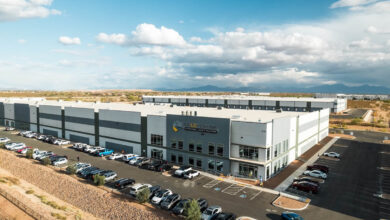
UArizona Alfie Norville Gem and Mineral Museum to Exhibit Asteroid Bennu Sample
As NASA saw its first asteroid sample return to Earth this past weekend, three museums took particular notice, knowing that they had been chosen to display small examples of the newly landed space rock material.
The Smithsonian’s National Museum of Natural History in Washington, D.C., Space Center Houston in Texas and the University of Arizona’s Alfie Norville Gem and Mineral Museum in Tucson were quietly selected by NASA to exhibit a piece of the asteroid Bennu as brought back to Earth by the space agency’s OSIRIS-REx mission. The probe’s sample return capsule touched down in the Utah desert on Sept. 24.
collectSPACE.com first learned of the chosen locations from sources with knowledge of NASA’s plans. The museums then confirmed the details in separate statements.
A spokesperson for the Alfie Norville Gem and Mineral Museum told collectSPACE that a sample is expected to go on display in November and more details would be shared when available.
While the details of the displays are still being worked out, including the size and nature of the material they will contain, the venues have been told to be ready as early as mid-November for the possible delivery of their Bennu specimen. First, though, scientists need to inspect, categorize and begin studying the contents of the OSIRIS-REx capsule.
Fortunately, there are indications that the spacecraft landed on Earth with more material than the mission was targeted to return. According to NASA, the capsule is estimated to be holding about a half a pound of rocks and soil, or about 8.8 ounces (250 grams).
“We promised the agency we would bring back 2 ounces, or about 60 grams, of material,” UArizona’s Dante Lauretta, principal investigator for the OSIRIS-REx (or Origins, Spectral Interpretation, Resource Identification and Security-Regolith Explorer) mission said at a press briefing. “We believe, based on some very clever spacecraft engineering from our partners at Lockheed Martin — measuring the momentum change on the spacecraft as we articulated its robotic arm — that we have at least four times that material.”
NASA scientists on Tuesday found black dust and debris on the avionics deck of the OSIRIS-REx science canister, hinting at the material held within.
Most of that is intended for scientific study. From the specially-built curation lab at NASA’s Johnson Space Center in Houston, the plan is to distribute portions of asteroid Bennu to a sample analysis team of more than 200 members from more than 35 globally distributed institutions. Approximately six months after the return, a sample catalog will be released, and more of the material from Bennu will be made available for research by scientists around the world for decades to come.
Pictured above – This image, showing asteroid Bennu's spinning-top shape, was taken by the MapCam camera on NASA's OSIRIS-REx spacecraft on April 29, from a distance of 5 miles. From the spacecraft's vantage point, half of Bennu is sunlit and half is in shadow. Credit: NASA/Goddard/University of Arizona





